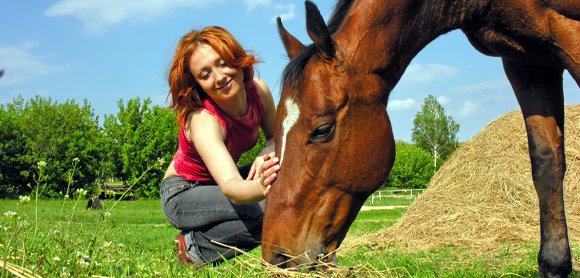
Equine Grass Sickness 101: How to protect your horse
Equine grass sickness is a devastating disease that can affect horses of all ages and types. The Moredun Foundation Equine Grass Sickness Fund is dedicated to finding the cause, developing a treatment and educating horse owners about EGS. In this article, we talk to the EGSF to bring you the latest information on grass sickness and how to decrease your risk.
What is grass sickness?
Despite investigating for the last 100 years, relatively little is known about equine grass sickness (EGS). The complex disease attacks your horse’s nervous system, compromising their ability to swallow and preventing the movement of food through the digestive tract. It can result in a build-up of fluid in the stomach and small intestine, dehydration and impaction of the large intestine.
EGS is most common in the spring and early summer, but it can occur at any time of the year and some years see a second, smaller peak in the early autumn.
What causes grass sickness in horses?
The definitive cause of the disease is unknown but is likely to be a combination of factors – the currently favoured theory under investigation is the possible involvement of Clostridium botulinum, the bacteria that causes botulism.
There are three types of EGS which are characterised by the speed of onset — acute, sub-acute and chronic. The overall mortality rate is 80%, making it a very serious illness. Around half of chronic cases survive and the majority of these horses are able to return to work.
Is my horse at risk?
EGS can affect any horse and the UK has the highest number of reported incidences in the world. But some horses are more at risk than others, including:
- Younger horses aged 1-9 years old
- Horses in the East of the country, particularly in Scotland
- Overweight horses
- Horses who have recently moved to new grazing
Grass sickness prevention advice
As it’s still unclear what causes the disease, it’s difficult to know for certain how to prevent it. But current research suggests that changing your management practices to avoid the known risks is the best place to start.
Not all of the following suggestions will be practical for all horse owners, so it’s best to prioritise horses who are most at risk during high-risk seasons. Here are seven grass sickness prevention strategies you can use to help protect your horse:
- Avoid grazing areas where there have been previous cases of grass sickness or recent soil disturbance, for example, from harrowing
- Minimise soil exposure by moving horses before grazing gets too short or fields are poached
- Avoid sudden changes to your horse’s diet
- Avoid overuse of ivermectin-based wormers
- Co-graze with ruminants (animals that chew cud) like cattle, sheep, goats and deer
- Poo-pick regularly
- Feed supplementary forage alongside grazing, such as hay or haylage
- Stable horses when the weather is cool and dry with irregular frosts
What are the equine grass sickness signs to look out for?
Diagnosing grass sickness can be challenging and often involves looking for patterns of clinical signs. If your horse is suffering from any of these symptoms, you should treat it as an emergency and call your vet immediately.
There are three types of grass sickness — acute, sub-acute and chronic.
1. Acute grass sickness
In acute cases you’ll see signs of colic, including rolling, pawing and looking at the flanks, drooling and difficulty swallowing. Your horse might also:
- Look bloated and is likely to be constipated
- Foul-smelling nasal discharge
- Pass small, hard poos with a ‘cheesy’ coating of mucus
- Muscle tremors and patchy sweating
Unfortunately, in this form the disease is fatal and euthanasia is the kindest option once the diagnosis has been made.
2. Sub-acute grass sickness
Sub-acute cases show similar signs, but with less severity. Accumulation of fluid is less likely to occur, but they are likely to be:
- Sweating
- Mild to moderate colic and difficulty swallowing
- Muscle tremors
- Rapid weight loss
They may manage to eat small amounts, but these horses are likely to die or require euthanasia within a week.
3. Chronic grass sickness
With chronic cases, the signs come on more slowly and only some cases show mild, intermittent colic. Horses are likely to have a reduced appetite and will have difficulty swallowing, but they won’t drool, accumulate fluid in the stomach or suffer from severe constipation. The most important indicators to look out for are:
- Reduced appetite and difficulty swallowing
- Rapid and severe weight loss
Working together for a brighter future
The Moredun Foundation Equine Grass Sickness Fund (EGSF) is the UK’s only registered charity specifically dedicated to raising funds for research into the causes of EGS and improving the treatment of chronic cases.
How can you help?
The EGSF is currently working on a new project that will create a nationwide biobank of samples and case studies for use in future research. The project will recruit specially trained vet ambassadors who will be ready to take horse samples in the event of an EGS case, as well as owner ambassadors to help collect case reports and botanical samples, which means you can get involved.
Kate Thomson of the EGSF explains: “You can take part in this exciting project by becoming an EGS detective. Please ask your vet to sign up as a vet ambassador and get in touch with us to sign up as an owner ambassador.”
Visit grasssickness.org.uk to find out more about the latest research.
Do you own a Grass Sickness Survivor? Share your stories with us on Facebook.


